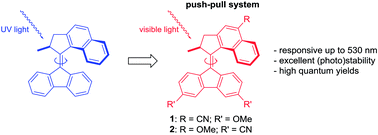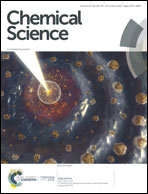Photoefficient 2nd generation molecular motors responsive to visible light†
Abstract
Molecular motors that operate with high efficiency using visible light are attractive for numerous applications. Here the synthesis and characterisation of three novel visible light switchable 2nd generation molecular motors is presented. Two of them are based on push–pull systems with the third one possessing an extended π-system. With a maximum effective excitation wavelength of 530 nm we designed the most red-shifted artificial rotary motor known to date. All three motors benefit from efficient switching to the metastable isomer, high quantum yields and excellent photostability setting them apart from visible light switchable motors reported previously. The activation barriers of the rate-determining thermal helix inversion could be accurately predicted using DFT calculations and differences between the motors can be explained by distinct transition state structures. Enantiomers of push–pull motors were successfully separated and their helical twisting power in E7 liquid crystals was determined.

- This article is part of the themed collection: 2019 Chemical Science HOT Article Collection


 Please wait while we load your content...
Please wait while we load your content...